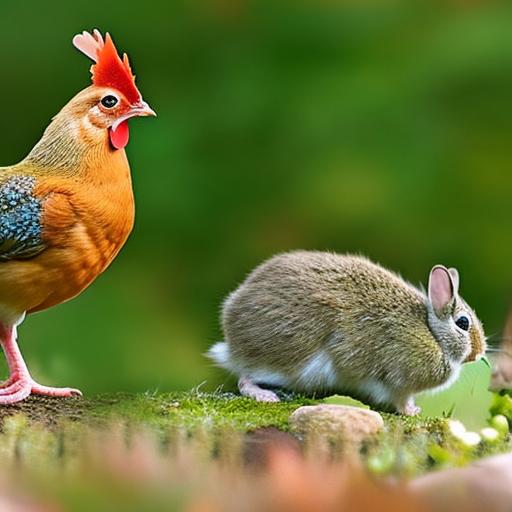Keeping chickens and rabbits together is a popular practice among homesteaders and backyard farmers. It offers numerous benefits, including natural pest control, fertilizer production, companionship for the animals, and cost-effectiveness. Personally, I have been keeping chickens and rabbits together for several years and have found it to be a rewarding and enjoyable experience.
Key Takeaways
- Keeping chickens and rabbits together is a popular trend among small-scale farmers and homesteaders.
- The benefits of keeping chickens and rabbits together include reduced feed costs, improved soil fertility, and increased pest control.
- Chickens and rabbits can be compatible if introduced properly and given enough space.
- Housing requirements for chickens and rabbits include separate sleeping areas and protection from predators.
- Feeding requirements for chickens and rabbits vary, but both need a balanced diet and access to fresh water.
Benefits of keeping chickens and rabbits together
One of the main benefits of keeping chickens and rabbits together is natural pest control. Chickens are excellent at foraging and will eat insects, slugs, and other pests that may harm your garden or crops. Rabbits, on the other hand, can help control weeds by eating them. By keeping these two animals together, you can create a natural balance in your garden or farm.
Another benefit is fertilizer production. Both chickens and rabbits produce high-quality manure that can be used as fertilizer for your plants. Chicken manure is rich in nitrogen, while rabbit manure is high in phosphorus and potassium. By combining these two types of manure, you can create a well-balanced fertilizer that will promote healthy plant growth.
Keeping chickens and rabbits together also provides companionship for the animals. Chickens are social creatures and enjoy the company of other animals. Rabbits, although more solitary by nature, can still benefit from having other animals around. By keeping these two species together, you are providing them with the opportunity to interact and form bonds.
Lastly, keeping chickens and rabbits together can be cost-effective. Both animals have relatively low maintenance costs and can provide you with a source of food, such as eggs from chickens and meat from rabbits. By combining these two animals in one enclosure, you can maximize your resources and save money in the long run.
Understanding the compatibility of chickens and rabbits
While keeping chickens and rabbits together can be beneficial, it is important to understand their differences in behavior and temperament. Chickens are more social and can be quite active, while rabbits are more solitary and prefer a quiet environment. These differences can sometimes lead to conflicts if not properly managed.
To prevent potential conflicts, it is important to provide separate areas for each animal within the enclosure. This can be done by using dividers or separate hutches. By giving each animal their own space, you can minimize the chances of aggression or territorial behavior.
When choosing breeds, it is important to select ones that are more compatible with each other. Some chicken breeds, such as the Buff Orpington or Australorp, are known for their calm and docile nature, making them more suitable for cohabitation with rabbits. Similarly, some rabbit breeds, such as the New Zealand or Californian, are known for their friendly and tolerant temperament.
Housing requirements for chickens and rabbits
When keeping chickens and rabbits together, it is important to provide them with a suitable enclosure that meets their specific needs. The size and design of the enclosure will depend on the number of animals you have and the available space.
The enclosure should be spacious enough to allow both chickens and rabbits to move around comfortably. It should also have secure fencing to prevent predators from entering. Additionally, it is important to provide adequate shelter from the elements, such as a coop for chickens and a hutch for rabbits.
Nesting boxes and bedding should also be provided for both animals. Chickens require nesting boxes where they can lay their eggs, while rabbits need a comfortable area where they can rest and sleep. The bedding should be clean, dry, and free from any harmful substances.
Proper ventilation and lighting are also important considerations. The enclosure should have good airflow to prevent the buildup of ammonia from animal waste. Additionally, natural light or artificial lighting should be provided to ensure that both chickens and rabbits have a regular day-night cycle.
Feeding requirements for chickens and rabbits
Chickens and rabbits have different dietary needs and require specific types of feed. Chickens are omnivores and require a balanced diet that includes grains, protein, and minerals. They can be fed a commercial chicken feed or a homemade mix of grains, such as corn, wheat, and soybean meal.
Rabbits, on the other hand, are herbivores and require a diet that is high in fiber. They should be fed a commercial rabbit pellet that is specifically formulated for their nutritional needs. Additionally, they should be provided with fresh hay and a variety of vegetables to ensure a well-rounded diet.
Supplemental treats and greens can also be given to both chickens and rabbits. Chickens enjoy treats such as mealworms, fruits, and vegetables. Rabbits can be given treats such as carrots, apples, and leafy greens. However, it is important to feed these treats in moderation to prevent obesity or digestive issues.
Both chickens and rabbits require access to clean and fresh water at all times. Water should be provided in containers that are easy to clean and refill. It is important to regularly check the water supply to ensure that it is not contaminated or frozen during colder months.
Health concerns when keeping chickens and rabbits together

When keeping chickens and rabbits together, there are certain health concerns that need to be addressed. Diseases can be transmitted between the animals if proper precautions are not taken. It is important to regularly monitor the health of both chickens and rabbits and take appropriate measures to prevent the spread of diseases.
Parasite prevention and treatment is also important when keeping these animals together. Both chickens and rabbits can be susceptible to external parasites such as mites or lice. Regular inspections should be conducted, and appropriate treatments should be administered if any signs of infestation are detected.
Regular health checks should be conducted for both chickens and rabbits. This includes checking for any signs of illness or injury, such as changes in behavior, loss of appetite, or abnormal feces. If any concerns are identified, it is important to consult a veterinarian for proper diagnosis and treatment.
Tips for managing chickens and rabbits in the same enclosure
Managing chickens and rabbits in the same enclosure requires careful planning and regular maintenance. Here are some tips to help you successfully manage these animals together:
1. Provide separate areas: As mentioned earlier, it is important to provide separate areas for each animal within the enclosure. This will help minimize conflicts and ensure that each animal has their own space.
2. Regular cleaning and maintenance: Regular cleaning and maintenance of the enclosure is essential to prevent the buildup of waste and the spread of diseases. This includes removing soiled bedding, cleaning water containers, and disinfecting the enclosure periodically.
3. Monitor behavior and health: It is important to regularly monitor the behavior and health of both chickens and rabbits. This includes observing their interactions, checking for any signs of aggression or illness, and addressing any concerns promptly.
Common behavioral issues with chickens and rabbits
When keeping chickens and rabbits together, there are some common behavioral issues that may arise. These include aggression towards each other, dominance issues, and nesting or territorial behavior.
Aggression towards each other can occur if one animal feels threatened or if there is competition for resources such as food or nesting areas. To prevent aggression, it is important to provide enough space and resources for both animals. Additionally, monitoring their interactions and separating them if necessary can help prevent conflicts.
Dominance issues can also arise, especially among chickens. Chickens have a pecking order within their flock, and introducing rabbits into their environment can disrupt this hierarchy. It is important to monitor their interactions and intervene if any bullying or aggressive behavior is observed.
Nesting and territorial behavior can be seen in both chickens and rabbits. Chickens may become protective of their nesting boxes and may exhibit aggressive behavior towards rabbits that approach them. Similarly, rabbits may become territorial and may exhibit aggressive behavior towards chickens that enter their space. Providing separate nesting areas for chickens and rabbits can help minimize these issues.
Harvesting eggs and meat from chickens and rabbits
One of the benefits of keeping chickens and rabbits together is the ability to harvest eggs from chickens and meat from rabbits. Proper techniques should be followed to ensure the safety and humane treatment of the animals.
When collecting eggs from chickens, it is important to handle them with care to prevent breakage. Eggs should be collected daily to prevent them from becoming dirty or damaged. They should be stored in a cool and dry place until they are ready to be used.
When harvesting meat from rabbits, it is important to use humane methods. This includes ensuring that the animal is properly stunned or euthanized before processing. It is also important to follow proper food safety practices during the butchering process to prevent contamination.
Safety precautions should always be followed when handling both eggs and meat. This includes washing hands thoroughly after handling animals or their products, as well as properly cooking eggs and meat to prevent foodborne illnesses.
Conclusion and final thoughts on keeping chickens and rabbits together
In conclusion, keeping chickens and rabbits together can be a rewarding and beneficial practice for homesteaders and backyard farmers. It offers natural pest control, fertilizer production, companionship for the animals, and cost-effectiveness. However, it is important to understand the compatibility of these animals, provide suitable housing and feeding requirements, address health concerns, manage behavioral issues, and follow proper techniques for harvesting eggs and meat.
Personally, I have found keeping chickens and rabbits together to be a fulfilling experience. It has allowed me to create a harmonious environment where these animals can thrive and contribute to my homestead. I encourage anyone interested in trying it out to do their research, seek advice from experienced individuals, and be prepared for the challenges and rewards that come with it.
If you’re considering keeping chickens and rabbits together, you may find this article on Poultry Wizard quite helpful. It discusses the benefits and considerations of cohabitating these two animals in your backyard. From providing companionship to reducing pests, there are several advantages to keeping chickens and rabbits together. To learn more about this topic, check out the article here.
FAQs
Can chickens and rabbits live together?
Yes, chickens and rabbits can live together in the same coop or hutch as long as they have enough space and are properly introduced.
What are the benefits of keeping chickens and rabbits together?
Keeping chickens and rabbits together can provide mutual benefits such as companionship, pest control, and manure management. Chickens can help control pests in the rabbit’s hutch, while rabbits can provide manure for the garden.
What are the risks of keeping chickens and rabbits together?
The main risk of keeping chickens and rabbits together is the potential for aggression between the two species. Chickens may peck at rabbits, causing injury or stress. Additionally, rabbits may carry diseases that can be harmful to chickens.
How should chickens and rabbits be introduced?
Chickens and rabbits should be introduced slowly and carefully. It is best to keep them separated at first and gradually introduce them to each other’s scents and sounds. Supervision is important during the introduction process to ensure that no aggression occurs.
What kind of housing is suitable for chickens and rabbits?
A coop or hutch that is large enough to accommodate both species is suitable for keeping chickens and rabbits together. The housing should be well-ventilated, secure, and provide separate areas for each species to retreat to if needed.
What should be the diet of chickens and rabbits kept together?
Chickens and rabbits have different dietary needs, so it is important to provide separate food and water sources for each species. Chickens require a diet high in protein, while rabbits need a diet high in fiber. Consult with a veterinarian or animal nutritionist for specific dietary recommendations.
Meet Walter, the feathered-friend fanatic of Florida! Nestled in the sunshine state, Walter struts through life with his feathered companions, clucking his way to happiness. With a coop that’s fancier than a five-star hotel, he’s the Don Juan of the chicken world. When he’s not teaching his hens to do the cha-cha, you’ll find him in a heated debate with his prized rooster, Sir Clucks-a-Lot. Walter’s poultry passion is no yolk; he’s the sunny-side-up guy you never knew you needed in your flock of friends!







